Brains of Sand A Abstract / overview
This section of the website attempts to summarize the key research stages of the project in graphical form.
Figure A.1
Stage 1 - cybernetics
Cybernetics is a word with several meanings, all of them closely related to one other. Within the context of this research project, the term denotes a completely different^ way of doing science and engineering than the kind of mathematical modelling that rose to prominence since the enlightenment. Until the middle of the twentieth century, few mathematicians and even fewer scientists had any inkling of the problems ahead. Indeed, the traditional way of doing science seemed to be stronger and more vigorous than ever, if Einstein's discovery of curved space-time and Crick & Watson's proof that DNA is the cause of Darwin's evolution are any standard to go by. Despite this apparent success, the real gap between the sciences and the humanities grew larger. The schism which existed at the turn of the 20th Century was exacerbated by the coup d'etat in psychology executed by Behaviourism, which we now regard more as a jingoistic cult than a legitimate scientific discipline.
Following ideas first outlined by Immanuel Kant, obscure Estonian researcher, Jakob von Uexkull proposed that conventional open loop (so-called 'feedforward') mathematics was unable^^ to adequately represent even the simplest closed feedback loops upon which all living systems depend. Figure A.1 (upper) depicts a basic feedback circuit, capable of managing a single sub-conscious (ie automatic) reflex within a larger animal (or a simple static autonomous organism) while figure A.2 depicts the same circuit, but with the addition of a source of top-down influence. This simple supervisory augmentation adds a locomotor (superposition) capacity to the homeostat's basic regulatory (differential) ability.
This discussion uses the term 'homeostat' to describe the first exemplar, and 'servostat' to describe the second. The servostat is a very interesting mechanism, because it characterizes a wide range of important machinery, from the common automotive cruise control to simple animal brains. It must therefore be a prime candidate for the functional pattern underlying all evolved creatures, a pattern that we know must exist, and one we need to identify if we hope to contest the 'blind watchmaker' arguments against evolution.
The key to understanding the servostat is to realize that it is a homeostat in which the setpoint is allowed to vary. Increasing the setpoint will cause the output of the circuit to increase, just like an amplifier. However the exact magnitude of the gain value (=output/input) of simple amplifiers cannot be guaranteed. A common method of avoiding this issue is to use the amp in an overdriven mode^^^. A better idea is to use a servostat, which represents the simplest example of declarative programming. The servostat programmer provides the machine with a series of goals to be reached (a high level method), rather than a list of instructions to be executed (a low-level method).
Herein lies a fundamental difference between computers and brains. All brain computations occur on a cybernetic (declaratively governed) substrate - the controlled switching (negative feedback) and graded cascades when a neuron fires (positive feedback). Even when the non-conscious brain seems to be procedural programmed (ie seems to execute scripts), in reality this is a syntactic operation.
By contrast, all computer operations, even ones that appear to be declaratively programmed, occur via a set of procedural substrates.
The brain's 'native' code is declarative at all levels, while the computers 'native' code is procedural at all levels. In the first case, declarative governance is made to look procedural via syntax (see section L on cognitive linguistics). In the second case, procedural governance can be made to look declarative by 'wrapping' the code up in a 'markup' file, which is passed to a dedicated execution module after each command edit. This is how XML and CSS works (see also Prolog Horn clauses, which are declarative goals dressed up to look procedural using syntactic 'sugar').
^the term 'numerical/iterative methods' denotes some, but not all of these uses.
^^Isaac Newton was aware of this issue, and attached his name to one of the earliest non-analytical (normally labelled 'iterative' or 'numerical') methods.
^^^When this is done, the factor ratio (=amplification/feedback) becomes a large but more stable value. Taken to the limit, and massively micro-miniaturised, such so-called 'op-amps' form the basis of all boolean circuit elements (eg NAND gates).

Figure A.2
Stage 2 - cybernetics (cont'd.)
To this day, only Anatol Feldman and this author have published the correct mechanism linking mind and motion in a clear and unambiguous way. The servostat is the key to understanding how top-down commands can cause a feedback regulated sub-system (such as the elbow joint/ biceps muscle) to obey without itself resisting those commands. The servostat solves the problem of how sensorimotor circuits are able to accept supervisory commands without resisting them as if they were external disturbances. This issue has long puzzled neurophysiologists, who in their desperation proposed the concept of 'efference copy'^.
The debunking of efference copy is not the only support for the servostat. The phenomenon of blindsight reveals the two constituents of visual consciousness, (a) identity and (b) position/motion of the objects perceived. These two components correspond directly to the two parts of the servostat, the identity preserving part (T, and P setpoint units) and the dynamic positioning part (L and F offset units).
^Feldman gives an excellent account of the problems with efference copy.
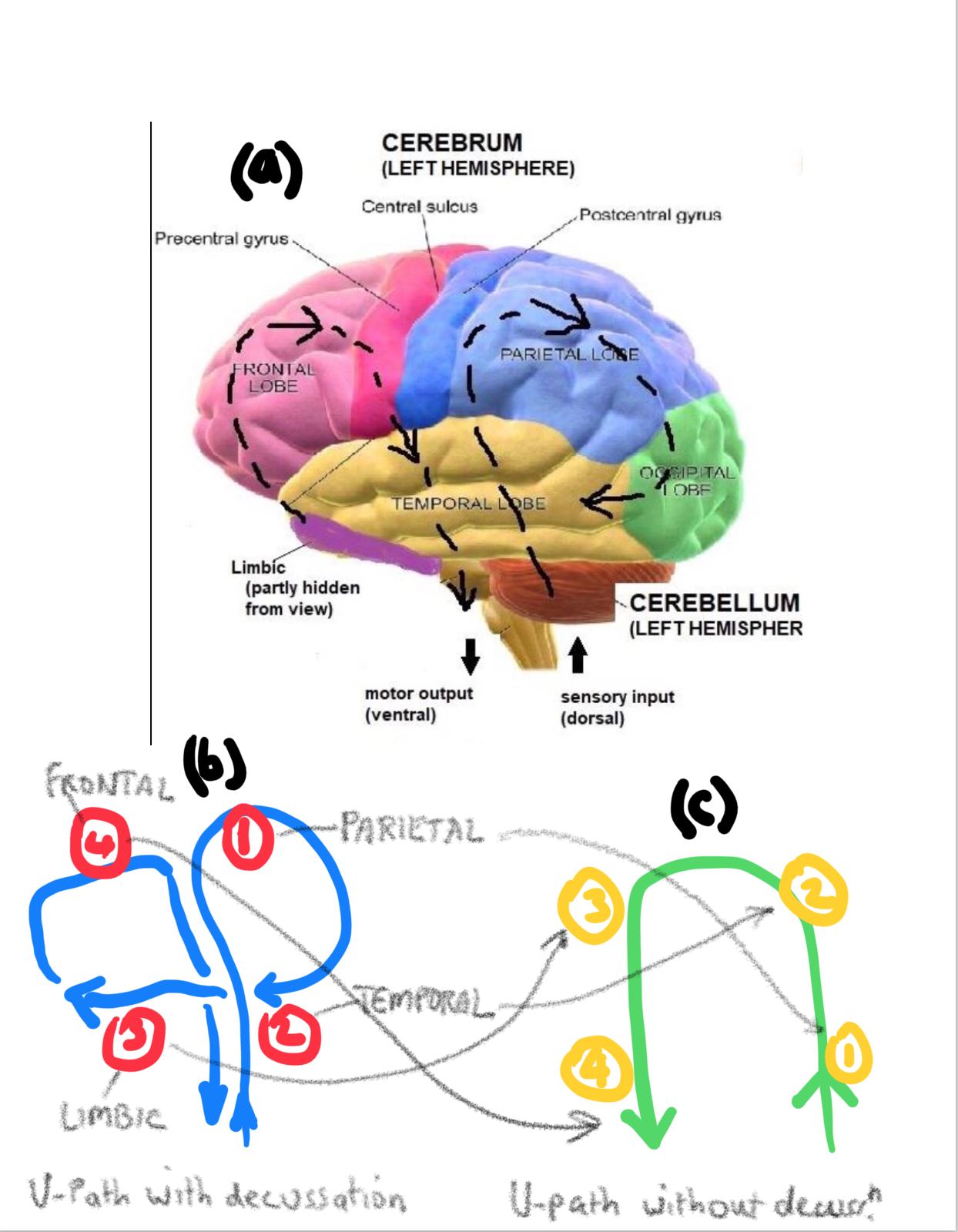
Figure A.3
Stage 3 - I/O path
We now address the brain's extant architecture. In particular, we ask ourselves why several well-respected researchers make the claim that the brain is such an infinitely complex machine that it will probably never be decoded. This claim violates the two best guides the independent scientist has- basic commonsense and natural skepticism. Figure A.3 (upper) suggests that there is a net information flow in the brain from input channel/s to output channel/s, with little or no difference in principle to those that govern a computer.
Creationists and science agnostics and deniers alike are fond of the 'blind watchmaker' objection to evolution. The example they tend to use is the eye. How could such a complex biocamera result from evolution?^. Fortunately, nature has presented us with the perfect test case- the evolution of the Lamprey, a competent visual hunter (a parasite), from its ancestor, the Hagfish, an almost identical animal except for its almost total blindness.
Any living pattern must be simple enough to be optimizable by evolution's combination of survivability fitness and sexual competitiveness, but at the same time complex enough to execute the detailed (eg eye's) functions. This begs the general question- how can a pattern be simultaneously simple and complex? We now know the answer to be fractals^^, which are recursive, space-filling curves with fractional Haussdorf dimension.
^Lamb, T.D. EVOLUTION OF THE EYE
Scientific American, July 2011
^^popularized by IBM's Benoit Mandelbrot in the 1980's.

Figure A.4
Stage 4 - mind -hierarchical data structures
The knowledge that fractals are doing some of the heavy lifting is not only comforting, but empowering. A brain design based on fractals is now a legitimate possibility, conceivable perhaps as the duplex (counterflow) pair of hierarchical data channels depicted in figure A.4 (below). This diagram depicts a mapping between the main lobes of the brain, and I/O channels of the GOLEM (Goal Oriented Linguistic Emulation of Mind). The Parietal (including Occipital) and Temporal lobes form the concrete and abstract parts of the input channel, while the Limbic and Frontal lobes form the abstract and concrete parts of the output channel.
It is a sad indictment on the current state of neuroscience that this simple mental model is not more popular, because it is an obvious first approximation in modelling the full complexity of the actual neuroanatomy. If the GOLEM model were more widely appreciated as a first approximation, it would tend to rule out the more exaggerated public estimates of the brain's computational capacity in favor of more realistic ones.
IBM's founder, Gordon Moore proposed an empirical law which has proved remarkably accurate. It predicted that the computing power of an average microprocessor chip will double every 1.5 years. However, much of this increase has been absorbed by the need to refresh many more screen pixels 25 or 30 times each second, which are driven by the consumer's increasing expectation of a more cinematic televisual experience. Something similar may well have happened in evolution, with the increases in brain capacity used to manage more entities in more detail, rather than used to produce more intelligence, per se. For example, the house fly and the human being who tries to kill it with a swatter both have around 20,000-30,000 genes, as well as (arguably) a similar level of sensorimotor ability - flies are mini-quadcopters with counterbalanced wing pairs and omnidirectional flight abilities . They control these complex flight organs with a nervous system whose overall plan looks remarkably like those of much larger animals^.
^Little wonder it is so hard to swat them!
Figure A.5

Stage 5 - fractalism, cont'd
At this stage of the reverse-engineering process (figure A.5), even though the diagram depicts a human brain, the 4-part GOLEM model describes the cognitive level of animals. If the model is expanded from 4-parts to 6-parts, human cognitive capacities can be modelled more directly. This must be done by introducing fractals.
The lower part of figure A.5 depicts the nub of the fractal argument, namely the choice of a 4th rank over 2nd rank fractal for the brain's architecture. It is at this point that the design 'game' becomes rather interesting, in that it introduces the possibility that the global GOLEM might be doing different things from the local GOLEMs. This leads to a more satisfying functional explanation for the language-based lateralization of the brain than currently exists.
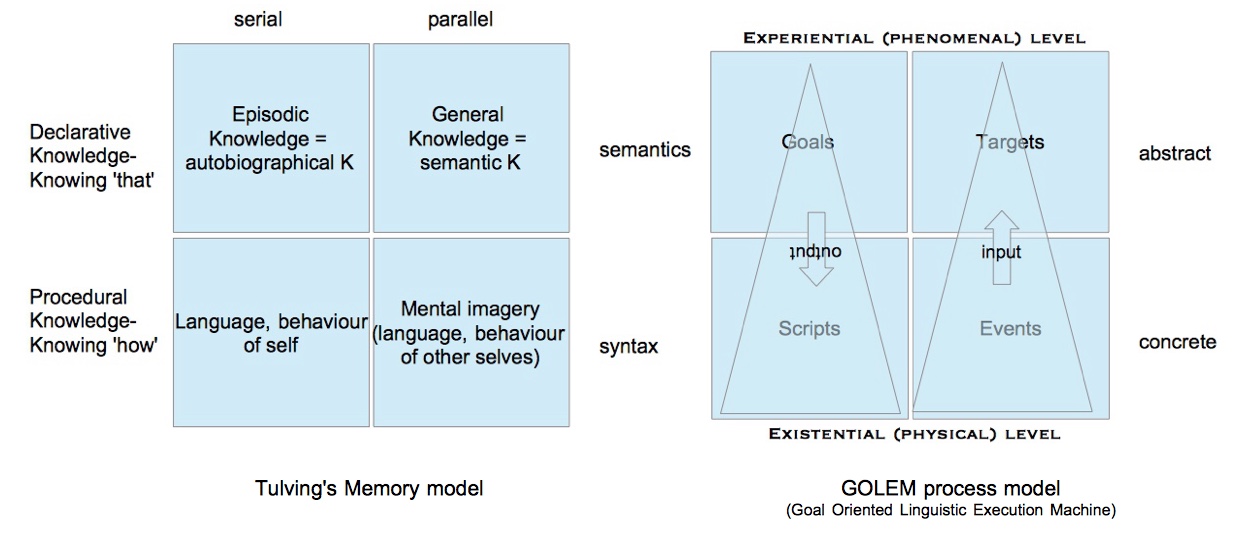
Figure A.6
Stage 6 - Proposal of GOLEM^ as subjective emulation
Figure A.6 depicts the detailed development of the human-based 6-GOLEM from the animal-based 4-GOLEM, by the incorporation of Tulving's memory model (A.6 upper diagram).
The lower diagram of figure A.6 depicts the actual fractal situation at left, which is topologically equivalent to a Sierpinski sponge, and the equivalent 6-GOLEM, depicted at right. The anagram COGESE describes the computational phases of the 'chambers' of the human 6-GOLEM, while the anagram GOES/GETS describes the computational phases of the 'chambers' of the human 4-GOLEM.
^the diagram contains a historic acronym of GOLEM - the correct one is Goal-Oriented Linguistic Emulation of Mind. Note that the GOLEM model is an emulation not a mere simulation, in that its functionality derives from its core structure, a duplex, counterflow pair of hierarchies.
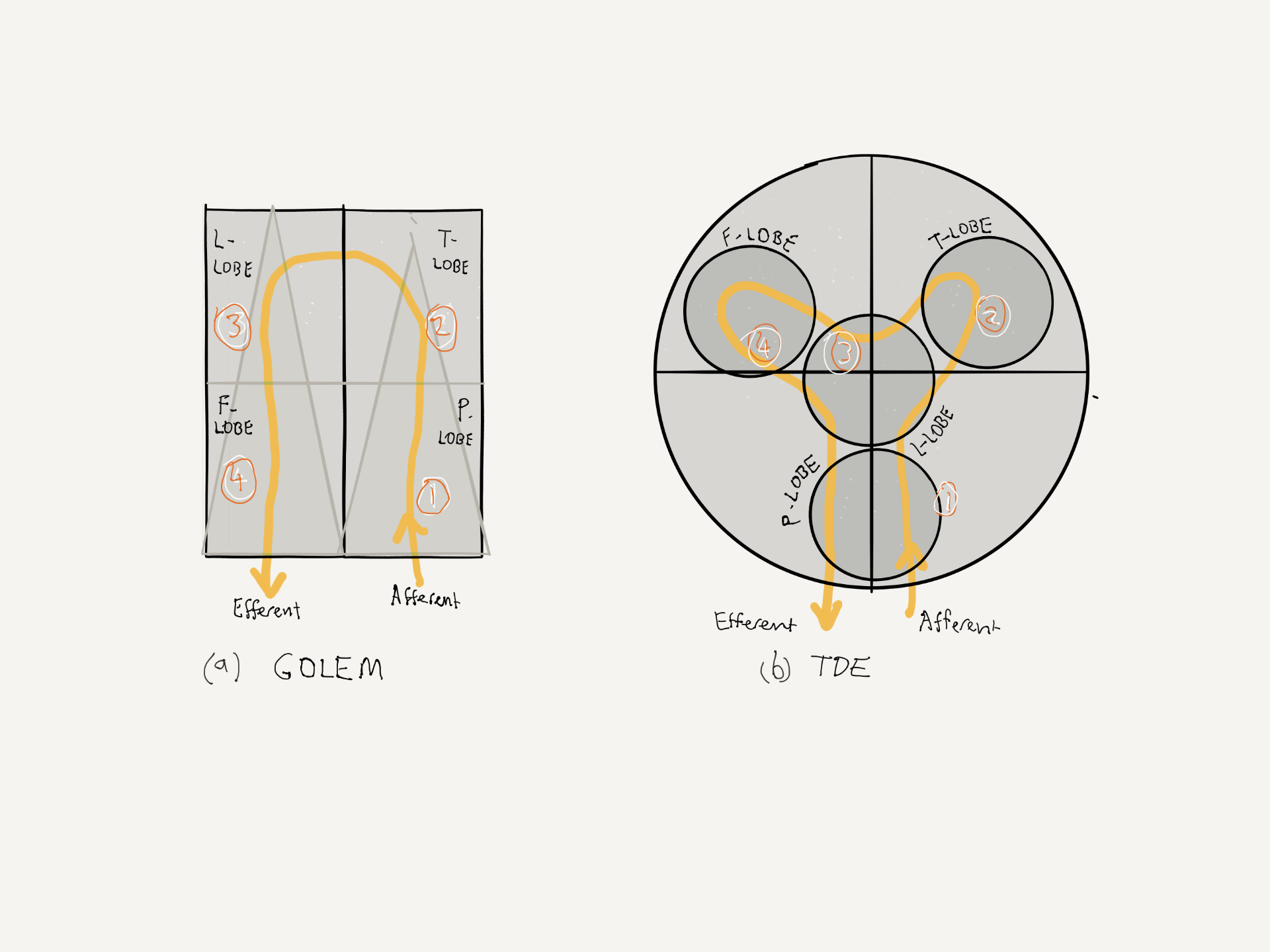
Figure A.7
Stage 7 - proposal of TDE (improved version of GOLEM)
The GOLEM is not the optimum form of the underlying 4-fractal. There are three main reasons why the recursively named TDE (=> TDE Differential Engine) was chosen as its successor-
(i) the TDE is symmetric about the limbic lobe at its center, an arrangement which matches the neuroanatomy of the brain (the limbic system is central in most animal brains).
(ii) the circular plan of the TDE is the same form as an epicyclic gear train. Epicyclic gears are so useful in mechanical engineering because they can produce various speed and torque ratios depending on which of the three rotating parts are held static. This aspect of the model echoes the trilateral possibilities of the real situation- eg when animals respond to metabolic needs, eg when hungry, the L-lobe drives the information flows in the other lobes. In this case, the central pinion can be visualised as driving the others around.
(iii) The TDE is (informally) equivalent to an extended Turing Machine, with the TM's endless tape being modelled as the 'ring' gear that surrounds the 4 central pinions. Continuing the analogy, the P-lobe is the movable READ/WRITE tape head, with the T-lobe and F-lobe representing the STATES and TRANSITIONS of the accompanying finite state automaton.
(iv) William James knew that the brain uses common (position, or perceptual) coding. The servostat, with its combination of global sensor codes and local motor codes, is a perfect example of position coding.
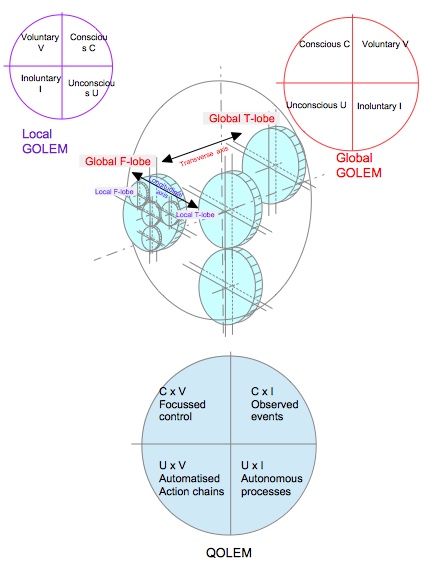
Figure A.8
Stage 8- GOLEM with qualia -->GOLEM x golem => QOLEM
Interactions* between Global GOLEMs and local GOLEMs introduce the possibility of physically realizable (ie machine-based) phenomenology or qualia. Firstly, local and global GOLEM's are constructed with slightly different interpretations placed upon the concrete and abstract (ie upper and lower) parts of their input and output channels. The upper and lower parts of the input channel are labelled 'conscious' and 'unconscious'. This step can be performed with confidence because the model thus far makes no presumption as to precise location of the boundary. The only implicit assumption, a reasonable one, is that unconscious mental contents represent items which are 'lower-level' (ie more concrete and numerous) than conscious contents.
There is a convention in physics that the covariant and contravariant forms of multidimensional quantities be be written as column and row vectors respectively. With the boolean predicate {C,U} written as a 1x2 column vector and boolean predicate {V,I} written as a 2x1 row vector, the multiplication of global and local GOLEMs yields a 4x4 multiqualiate (c.f. multivariate) matrix which has two desirable properties-
(i) the four quadrants of the matrix map nicely to the four identifiable modes of information processing (which combine to create our sense of self) in the brain and mind.
(ii) the second quadrant UxI suggests a satisfactory resolution of Libet's Paradox, by highlighting the potential separation of consciousness and volition^. It is entirely possible to voluntarily initiate a mental process (like pressing a button at a chosen tick of a 60 second clock) and not be conscious of doing so until some later moment.
Even the most advanced analysis^ of these phenomena uses the term 'conscious' in a semantically confusing manner which is not sufficiently rigorous for scientific purposes. Conscious/ Unconscious and Voluntary/ Involuntary are the opposed-binary dimensions used to label the input and output channels of both GOLEM (2 levels for animals) and COGESE (3 levels for humans). The terms 'self', 'subjectivity' or 'qualium/ qualia' should always be used to describe the internal architecture of the cross product of two GOLEMs, which TDE theory identifies as a QOLEM (the qualiate version of a GOLEM). This is SO much more than pedantic nit-picking, being the cause of an ultimately fatal (in a theoretical sense, of course) flaw in both Baar's and Tonioni's interpretation^ of the effects of callosotomy on the 'unity of self' - it is so very tempting to instinctively say 'consciousness' here!
TDE theory allows for the existence of a QOLEM wherever two GOLEM's of equal or lower fractal order can interact to make a cross product. The unity (homogeneity?) of the qualiate space is guaranteed by that operation. TDE theory (websites W(6) and earlier) also include the same error as Baars et al. Selfhood (sense of self) is more than consciousness, it includes agency. It is composed of four quadrants, each with a unique aspect of self, as shown in figure A.8 above, left.
*these interactions resemble the vector (a.k.a. 'outer' or 'cross'; c.f. the 'inner', 'dot' or 'scalar') product used by physicists and engineers.
^Pinto, Y et al (2017) Split Brain: Divided Perception but Undivided Consciousness. Brain 140; 1231 - 1237
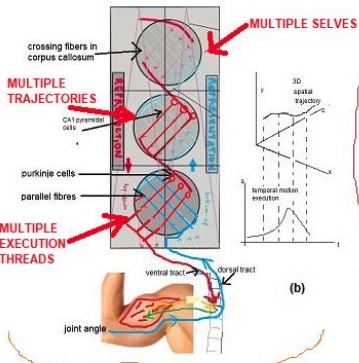
Figure A.9
Stage 9 - proposal of better cerebellum model
The GOLEM-based model of human mind (COGESE) consists of three levels of maps - see figure A.9 at left. Each one contains a neural crossbar matrix in which input patterns (linguistically equivalent to the pattern's semantics) represent sets of options which are chosen by the output patterns. The lowest crossbar matrix is that formed by the parallel fibers (=input lines)and purkinje cells (=output lines) in the cerebellum. This lowest subsystem executes the temporal dynamics of the declarative cybernetics of the next highest subsystem, the cerebrum. The 2nd level is a spatial modeler. The crossbar matrix intersection points represents the multiple sets of spatial trajectories currently being processed, typically computing where the self might collide with another subject or object (eg driving amongst cars which are all moving). The third level is the socio-linguistic level, which models multiple narratives, eg self amongst other selves, by managing subject::predicate (Piercean*) subset hierarchies.
*after the logician C.S. Pierce
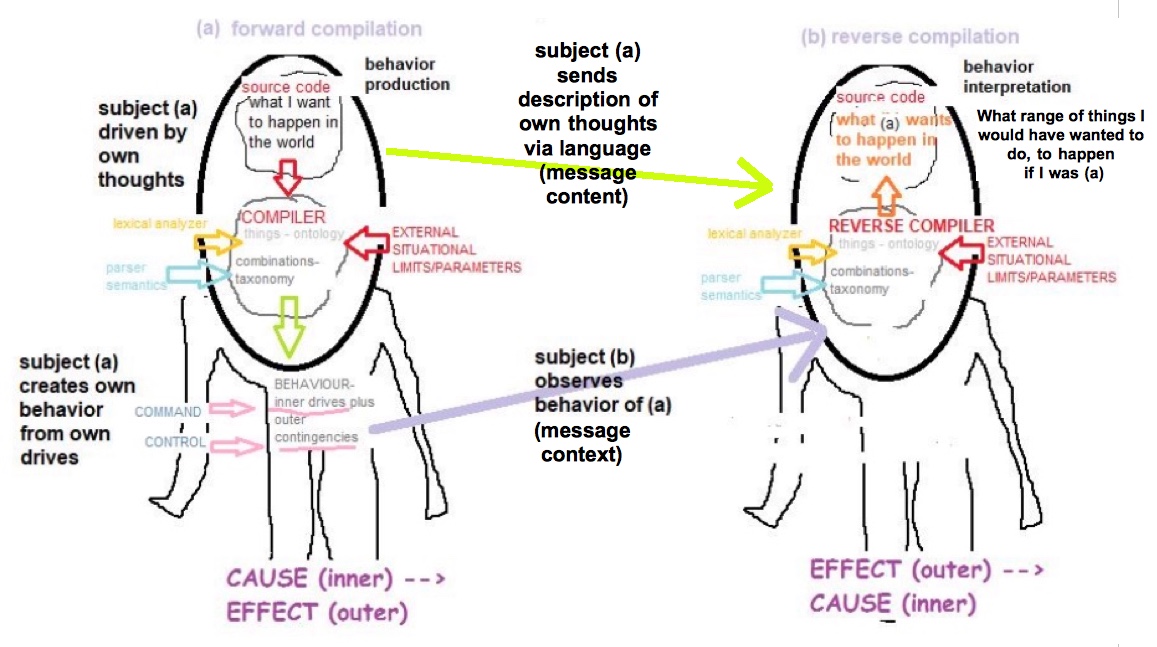

Figure A.10
Stage 10 - equivalence of thought and speech and how they create behavior via the (declarative) programming paradigm.
The linguistic model of cognition and the cognitive model of language are 'duals' or complementary viewpoints of each another. They form a six-level finite state machine in which the states (at each level) are represented by that level's cogno-linguistic semantics while the transitions between states are reproduced by the level's syntax. The definitions of syntax and semantics encountered in this emulation are more universal than other priors because they refer to a unified biocomputational model, and can be considered applicable over a wide range of domains and disciplines.
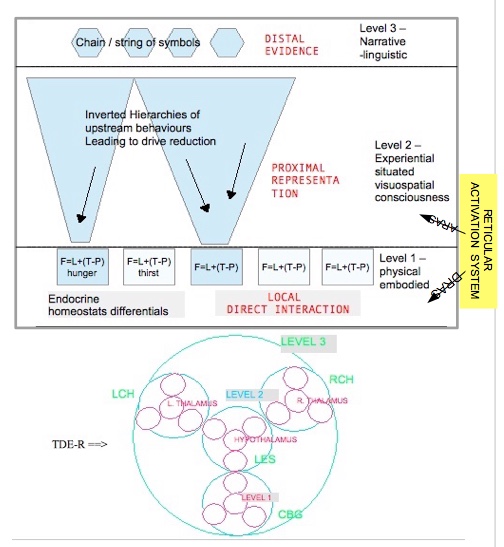
Figure A.11
Stage 11 - In the last part, Stage 10, we observed how the simple building blocks of BOTTOM-UP data structures and hierarchical linguistics resulted in the rapidly increasing complexity of the COGESE's architectonics. In this next stage, we undertake a similar exercise but from the TOP-DOWN (and mostly feedforward) command viewpoint, also known as causal/agency analysis.
We now ask the following question- what metabolic influences, neural circuitry and/or memory state machinery are caused by the organism's inbuilt goal-seeking drives? The Reticular Activation System plays a key coordinating role in these mission critical activities. In very general terms, EMOTIONS are situational and introspective appraisals of previous plans and actions, while CONSCIOUSNESS uses EMOTIONALITY to attribute relative measures of subjective importance to the situational 'hard points'.
The Descending RAS records the states and changes of EMOTIONS (expressions), broadly defined as low level (TDE # 0) embodied drives over each diurnal cycle, delimited by the hypothalamus, SCO and other sundry endocrine actuators. The Ascending RAS functions in a dual (complementary) role, by governing the states and changes of CONSCIOUSNESS (impressions) . The reader is reminded that the descriptions thus far pertain mainly to animal minds, since they describe mechanisms in Level 1 and Level 2 only. In the TDE grand overview, Emotions and Consciousness are evolution's legacy to the animal kingdom. Later, evolution gave humans two other capacities over and above those already possessed by the animalia. These are of course, the power to speak and the intelligence to comprehend.
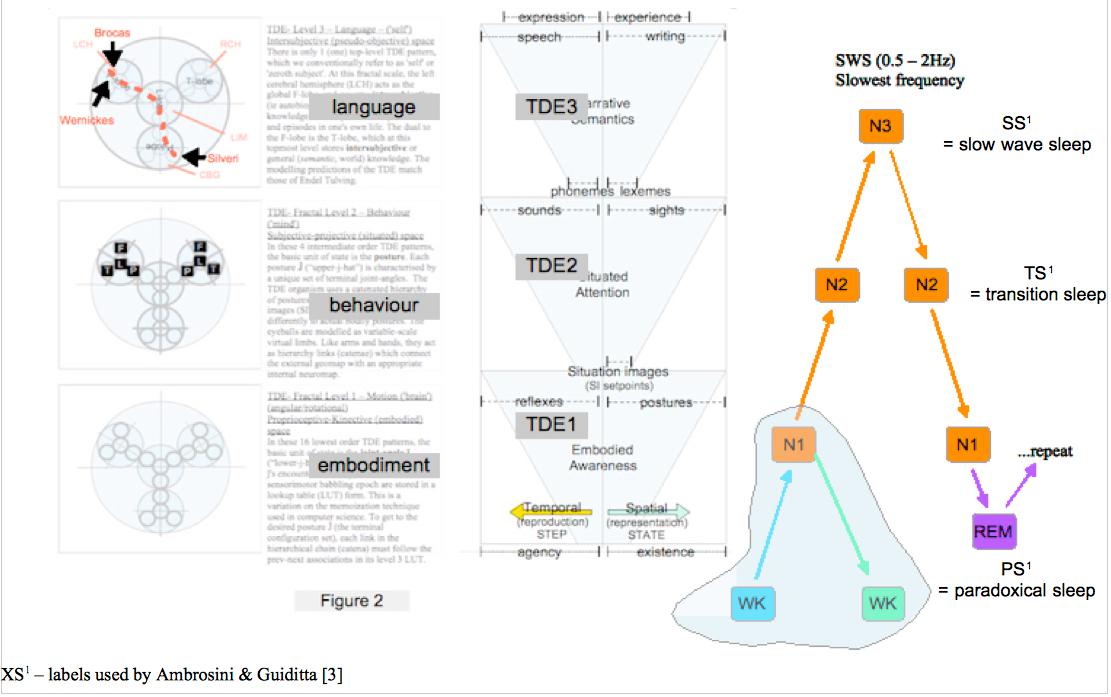
Figure A.12
Stage 12 - sleep and memory consolidation
There is an overwhelming body of evidence which supports the assertion that the purpose of sleep is memory consolidation^.
^Other reasons arise from time to time but these are the noise rather than signal.
Figure A.13
Stage 13 - the role and regulation of emotions and how consciousness and emotions represent feedforward and feedback forms of the animal's/human's behavioral governance mechanism.
In figure A.13, consciousness and emotions are placed in their correct, subjective, cognitive-behavioral context. They form the feedforward and feedback components of an organism's self-governance at level 2, the spatio-temporal level. We share levels 1 and 2 (left and middle columns of the table) with animals, but not level 3 (rightmost column of the table) which is unique to humans (+ maybe some higher primates and AI-based robots). Meaning can be interpreted as the external analog to knowledge, which is internal. These concepts describe feedforward and feedback aspects of memory, where 'memory' refers to biological and artificial information capacity of brains and computers.
This may seem to some like an elaborate naming exercise, but these labels are not arbitrary- it has been demonstrated that this categorization really does 'carve nature at the joints'.
